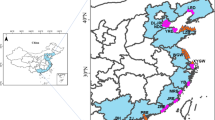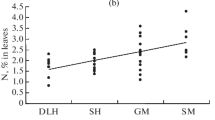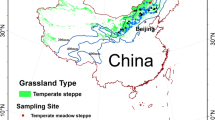Abstract
The nitrogen isotope of soil is of emerging significance as an indicator of climatic change and biogeochemical cycle of nitrogen in nature systems. In this paper, the nitrogen content and isotopic composition of modern ecosystems from arid and semiarid Loess Plateau in northwestern China, including plant roots and surface soil, were determined to investigate trends in δ15N variation of plant roots and soil along a precipitation and temperature gradient in northwestern China under the East Asian Monsoon climate condition. The δ15N values of surface soil from the study area vary from −1.2‰ to 5.8‰ but from −5.1‰ to 1.9‰ in the plant roots. Our results indicate that (1) although the isotopic compositions of both plant roots and surface soil change with a similar trend along the climate gradient, the apparent nitrogen difference between plant roots and soil existed, with Δδ15N values ranging from 0.3‰ to 7.2‰ with average of 4.1‰ and (2) mean annual precipitation (MAP) is the dominant factor for isotopic composition of plant-soil nitrogen in the Loess Plateau, and the δ15N values are less correlated with MAT; we suggest that nitrogen isotopic composition of soil is a potential tracer for environmental changes.
Similar content being viewed by others
References
Schuur E A G, Matson P A. Net primary productivity and nutrient cycling across a mesic to wet precipitation gradient in Hawaiian montane forest. Oecologia, 2001, 128: 431–442
Heaton T H E. The 15N/14N ratios of plants in South Africa and Namibia: relationship to climate and coastal/saline environments. Oecologia, 1987, 74: 236–246
Handley L L, Odee D, Scrimgeour C M. 15N and 13C patterns in savanna vegetation: dependence on water availability and disturbance. Funct Ecol, 1994, 8: 306–314
Piccolo M C, Neil C, Mellilo J M, et al. 15N natural abundance in forest and pasture soils of the Brazilian Amazon Basin. Plant Soil, 1996, 182: 249–258
Hogberg P. 15N natural abundance in soil-plant systems. New Phytol, 1997, 137(2): 179–203
Schulze E D, Williams R J, Farquhar G D, et al. Carbon and nitrogen isotope discrimination and nitrogen nutrition of trees along a rainfall gradient in northern Australia. Aust J Plant Physiol, 1998, 25: 413–425
Robinson D, Handley L L, Scrimgeour C M. A theory for 15N/14N fractionation in nitrate-grown vascular plants. Planta, 1998, 205: 397–406
Shearer G, Duffy J, Kohl D H, et al. The nitrogen-15 abundance in a wide variety of soils. Soil Sci Soc Am J, 1978, 42: 899–902
Mariotti A, Pierre D, Vedy J C, et al. The abundance of natural ni trogen 15 in the organic matter of soils along an altitudinal gradient, Catena, 1980, 7: 293–300
Garten C T J. Variation in foliar 15N abundance and the availability of soil nitrogen on Walker Branch Watershed. Ecology, 1993, 74: 2098–2113
Evans R D, Ehleringer J R. A break in the nitrogen cycle in aridlands? Evidence from δ15N of soils. Oecologia, 1993, 94: 314–317
Neff J C, Townsend A R, Gleixner G, et al. Variable effects of nitrogen additions on the stability and turnover of soil carbon. Nature, 2002, 419: 915–917
Hipkin C R, Simpson D J, Wainwright S J, et al. Nitrification by plants that also fix nitrogen. Nature, 2004, 430: 98–101
Hogberg P, Hogberg M N, Quist M, et al. Nitrogen isotope fractionation during nitrogen uptake by ectomycorrhizal and non-mycorrhizal Pinus sylvestris. New Phytol, 1999, 142(3): 569–576
Austin A T, Sala O E. Foliar δ15N is negatively correlated with rainfall along the IGBP transect in Australia. Aust J Plant Physiol, 1999, 26: 293–295
Handley L L, Austin A T, Robinson D, et al. The 15N natural abundance (δ15N) of ecosystem samples reflects measures of water availability. Aust J Plant Physiol, 1999, 26: 185–199
Martinelli L A, Piccolo M C, Townsend A R, et al. Nitrogen stable isotopic composition of leaves and soil: tropical versus temperate forests. Biogeochemistry, 1999, 46: 45–65
Schulze E D, Farquhar G D, Miller J M, et al. Interpretation of increased foliar δ15N in woody species along a rainfall gradient in northern Australia. Aust J Plant Physiol, 1999, 26: 296–298
David R. δ15N as an Integrator of the Nitrogen Cycle. Trends Ecol Evol, 2001, 16(3): 153–162
Brenner D L, Amundson R, Baisden W T, et al. Soil N and 15N variation with time in a California annual grassland ecosystem. Geochim Cosmochim Acta, 2001, 65(22): 4171–4186
Amundson R, Austin A T, Schuur E A G, et al. Global patterns of the isotopic composition of soil and plant nitrogen. Global Biogeochem Cy, 2003, 17(1): 1031, doi:10.1029/2002GB001903
Aranibar J N, Otter L, Macko S A, et al. Nitrogen cycling in the soil—plant system along a precipitation gradient in the Kalahari sands. Global Change Biol, 2004, 10: 359–373
Swap R J, Aranibar J N, Dowty P R, et al. Natural abundance of 13C and 15N in C3 and C4 vegetation of southern Africa: patterns and implications. Glob Change Biol, 2004, 10: 350–358
Houlton B Z, Sigman D M, Schuur E A G, et al. Isotopic evidence for large gaseous nitrogen losses from tropical rainforests. Proc Natl Acad Sci USA, 2006, 103(23): 8745–8750
Houlton B Z, Sigman D M, Hedin L O. A climate-driven switch in plant nitrogen acquisition within tropical forest communities. Proc Natl Acad Sci USA, 2007, 104(21): 8902–8906
Ding Y H. Monsoons over China: Dordrecht/Boston/London. Kluwer Academic Publishers, 1994. 12–36
Zhu Z C. Basic features of forest steppe in the Loess Plateau (in Chinese). Sci Geogr Sin, 1994(2): 152–156
Peuke D, Gessler A, Rennenberg H. The effect of drought on C and N stable isotopes in different fractions of leaves, stems and roots of sensitive and tolerant beech ecotypes. Plant Cell Environ, 2006, 29: 823–835
Dijkstra P, Williamson C, Menyailo O, et al. Nitrogen stable isotope composition of leaves and roots of plants growing in a forest and a meadow. Isot Environ Healt S, 2003, 39(1): 29–39
Molina J A E, Clapp C E, Linden D R, et al. Modeling the incorporation of corn (Zea mays L.) carbon from roots and rhizodeposition into soil organic matter. Soil Biol Biochem, 2001, 33(1): 83–92
Huang C Y. Soil Science (in Chinese). Beijing: Chinese Agricultural Press, 2000. 192–198
Kitayama K, Iwamoto K. Patterns of natural 15N abundance in the leaf-to-soil continuum of tropical rain forests differing in N availability on Mount Kinabalu, Borneo. Plant and Soil, 2001, 229: 203–212
Kohls S J, Kessel C V, Baker D D, et al. Assessment of N2 fixation and N cycling by Dryas along a chronosequence within the forelands of the Athabasca Glacier. Soil Boil Biochem, 1994, 26(5): 623–632
Liu W G, Huang Y S. Reconstructing in-situ vegetation dynamics using carbon isotopic composition of biopolymeric residues in the central Chinese Loess Plateau. Chem Geol, 2008, 249: 348–356
Author information
Authors and Affiliations
Corresponding author
Additional information
Supported by National Natural Science Foundation of China (Grant Nos. 40673012 and 40599422), and National Basic Research Program of China (Grant No. 2004CB720200)
About this article
Cite this article
Liu, W., Wang, Z. Nitrogen isotopic composition of plant-soil in the Loess Plateau and its responding to environmental change. Chin. Sci. Bull. 54, 272–279 (2009). https://doi.org/10.1007/s11434-008-0442-y
Received:
Accepted:
Published:
Issue Date:
DOI: https://doi.org/10.1007/s11434-008-0442-y




